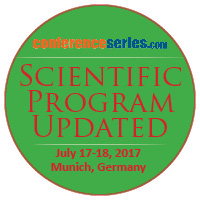
Johann Lechner
Clinic for Integrative Dentistry, Germany
Title: Hyperactivated signaling pathways of chemokine RANTES/CCL5 in osteopathies of jawbone in cancer and autoimmune diseases – Neglected dental cause of systemic diseases?
Biography
Biography: Johann Lechner
Abstract
Background: Despite significant therapeutic advances most malignancies, as well as adenocarcinomas of the breast, remained incurable. At the same time, the importance of the microenvironment surrounding the tumor cells with "silent inflammation" increases.
Objective: To check the suspected tumor-relevant inflammatory cytokine sources in fatty-degenerative osteonecrotic jaw bone (FDOJ), we analyze these conspicuously altered jawbone areas to assess the expression and quantification of cytokine expression.
Material & Method: In 38 tumor patients we determine the levels of cytokines by bead-based Luminex® analysis in samples of FDOJ.
Results: A high content of chemokine RANTES/CCL5 (R/C) in all 38 jawbone tissue samples of cancer patients was observed. A single case is characterized by high R/C levels in FDOJ sample and simultaneously by metastasizing cells inside the FDOJ sample. The R/C expression in all 38 FDOJ samples on an average were 35 fold higher compared to healthy jawbone.
Discussion: R/C interacts on several levels in immune responses and is considered in scientific literature as pathogenetic key point in tumor growth. The study supports a potential mechanism where FDOJ is a mediating link specifically in breast cancer (MaCa) and its metastasis. R/C is thus involved intensively in oncogenic propulsion progress developments.
Conclusion: The authors conclude from the data of FDOJ analysis that these areas express hyperactivated signal transduction of the chemokine R/C, induce pathogenetic autoimmune processes in tumors, MaCa and its metastasis and serve as a possible cause. The authors hypothesize that such changes in areas of improper and incomplete wound healing in the jawbone may lead to hyperactivated signaling pathways, and result in unrecognized sources of silent inflammation which may contribute to systemic disease patterns like cancer. Combining the R/C signal induction of tumors and the information we collect illustrated, it may be suggested to involve FDOJ in an integrative concept for tumor therapy.

